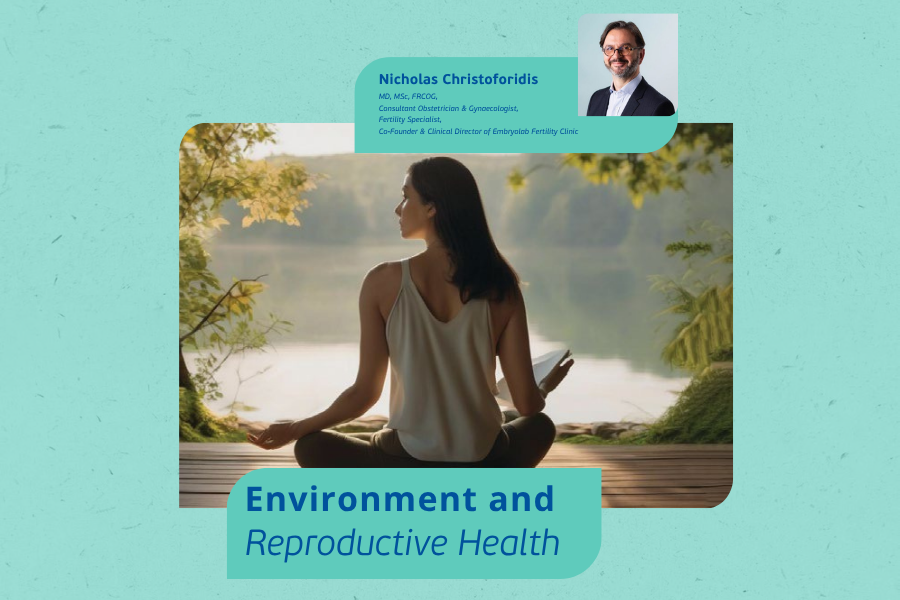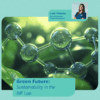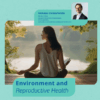
Dr. Nicholas Christoforidis, MD, MSc, FRCOG, Consultant Obstetrician & Gynaecologist, Fertility Specialist, Co-Founder & Clinical Director of Embryolab Fertility Clinic
In the contemporary world, the degradation of the environment through various pollutants has emerged as a significant concern, with pervasive effects on human health, particularly on reproductive capabilities. Both male and female reproductive systems are vulnerable to anthropogenic pollutants, which can lead to adverse outcomes such as reduced fertility, compromised reproductive health, and developmental issues in offspring. This essay explores the consequences of air pollution, water pollution, the role of endocrine disruptors found in common household items, and the harmful effects of heavy metals on reproduction, as well as their implications for ovarian reserve, sperm counts, infertility, and in vitro fertilization (IVF) treatments.
Air Pollution and Reproductive Health
Air pollution is a complex mixture of various harmful substances, including particulate matter (PM), nitrogen oxides, sulfur dioxide, and volatile organic compounds (VOCs). Numerous studies have documented the detrimental effects of air pollution on reproductive health. For men, exposure to high levels of air pollutants, particularly PM2.5, has been linked to decreased sperm quality and count. A meta-analysis revealed that men living in urban areas with significant air pollution had lower sperm motility and morphology compared to those in less polluted regions. The oxidative stress induced by these pollutants can damage sperm DNA, affecting not only fertility but also the health of potential offspring.
For women, the implications of air pollution on reproductive health are equally concerning. Research has indicated that exposure to high levels of pollutants can lead to complications such as pregnancy loss, preterm birth, and low birth weight. Additionally, air pollution has been associated with reduced ovarian reserve, which refers to the quantity and quality of a woman’s remaining eggs. A study in women undergoing fertility treatments found that those exposed to higher levels of air pollution had a significantly decreased response to ovarian stimulation, leading to fewer viable eggs available for fertilization.
Water Pollution and Its Effects
Water contamination is another crucial factor impacting reproductive health. Pollutants such as pesticides, heavy metals, pharmaceuticals, and industrial chemicals can enter water systems through agricultural runoff, industrial discharges, and improper waste disposal. These pollutants often disrupt endocrine function, leading to significant reproductive health issues.
Pesticides, commonly found in agricultural runoff, have been shown to influence hormone levels in both men and women. In men, elevated levels of certain pesticides have been linked to decreased testosterone levels, which can lead to diminished sperm production and infertility. For women, exposure to environmental contaminants in water can disrupt menstrual cycles and affect ovarian function, ultimately impacting fertility.
Heavy metals present in contaminated water, such as lead and mercury, pose serious risks to reproductive health as well. Studies highlight that lead exposure is associated with decreased sperm counts and motility, while mercury exposure can lead to neurodevelopmental issues in children once born. Women exposed to high levels of these metals may experience ovulatory dysfunction and increased rates of miscarriage.
Endocrine Disruptors: Everyday Chemicals in Plastics and Personal Care Products
Endocrine-disrupting chemicals (EDCs) are chemicals that interfere with the body’s endocrine (hormonal) system. These compounds are widely present in everyday products, including plastics, cosmetics, and personal care items. Common EDCs include bisphenol A (BPA), phthalates, and parabens. The ubiquitous nature of these chemicals raises significant concerns about their long-term effects on reproductive health.
BPA, often found in plastic containers and linings, is known to mimic estrogen, leading to hormonal imbalances. Research indicates that exposure to BPA can result in reduced sperm quality in men and adversely affect ovarian function in women. In vitro studies have shown that EDC exposure can lead to abnormal proliferation of ovarian cells, potentially diminishing the ovarian reserve.
Phthalates, which are used to increase flexibility in plastics, have similarly been linked to reproductive health issues. Studies suggest that phthalate exposure is associated with reduced testosterone levels in boys, leading to developmental and fertility issues later in life. Women exposed to phthalates may experience irregular menstrual cycles, endometriosis, and a higher risk of infertility.
Personal care products, including lotions, shampoos, and makeup, often contain EDCs that can be absorbed through the skin. Continuous exposure to these chemicals raises concerns over their cumulative effects on reproductive health. The intersection of these EDCs with other environmental pollutants may further exacerbate fertility challenges for both sexes.
Heavy Metals and Reproductive Outcomes
Heavy metals, including lead, mercury, cadmium, and arsenic, are known for their toxic effects on human health and reproduction. These metals may enter the body through contaminated water, food sources, and air pollution. The impact on fertility is profound and well-documented.
In men, lead exposure has been shown to impair spermatogenesis (the process of sperm production), resulting in lower sperm counts and motility. Furthermore, lead toxicity is associated with increased oxidative stress, which can lead to DNA fragmentation in sperm, increasing the risk of infertility and poor pregnancy outcomes.
Mercury, commonly found in certain fish and industrial waste, has been associated with a reduced sperm motility, as well as with a an increased chance of congenital anomalies.
Environmental Pollutants and In Vitro Fertilization
The relationship between environmental pollutants and in vitro fertilization is particularly critical. As assisted reproduction gains greater significance as an effective intervention for infertility, it is important to study the impact of environmental factors on treatment outcomes and the likelihood of pregnancy.
According to the current research data, exposure to environmental pollutants can result in decreased chances of success, as it appears to negatively affect both the number of oocytes produced and the number of embryos that will ultimately be used for an embryotransfer.
Although the action of endocrine disruptors seems to have a negative effect on the functioning of the reproductive system, more studies are needed before we can establish a clearer relationship with the likelihood of success in in vitro fertilization treatment. However, until then, limiting exposure to these factors is considered a reasonable precautionary measure, especially during the preparation phase for a pregnancy.
Need for Awareness, Information, and Interventions
The relationship between environmental pollutants and reproductive health underscores the urgent need for public awareness and information on this issue, as well as the necessity of adopting appropriate measures and interventions to control these factors.
Emphasis should be placed on educating the public about the sources of these pollutants and their impacts on reproductive health. Finally, state interventions in the form of regulations can positively contribute to efforts to reduce exposure to recognized pollutants, addressing emission controls of gases, chemicals, and plastics in broader industrial activities.





